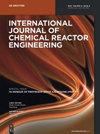Performance of photocatalytic oxidation surface with new geometry for indoor environment application: experimental and simulation
IF 1.6
4区 工程技术
Q3 Chemical Engineering
International Journal of Chemical Reactor Engineering
Pub Date : 2023-03-06
DOI:10.1515/ijcre-2022-0173
引用次数: 0
Abstract
Abstract Many studies of the photocatalytic oxidation process investigated on the removal efficiency and other variables of the input and output photoreactor. In the laboratory scale, it’s impossible, examination of the removal efficiency details, such as mass and energy transfer with air flow rate. Also, experimental methods request time consumption and money. For this reason, the simulation method can be used. The aim of this study was to prove that the validation of modeling approach in the photocatalytic oxidation process in the removal of toluene from air. Investigation of bed surface morphology, with FESEM, BET and TGA, shows acceptable monotonous of TiO2 nanoparticles on the ss plate. Furthermore, it was observed good adherence of nanoparticles on it. Experimental results on photocatalytic bed surface exhibited in the toluene concentration range of 10–40 ppm and flow rate of 2–5 l/min, with increasing flow and decreasing concentration, removal efficiency increased. The optimum removal point was 59% and 25 g/m3 min for 3.75 ppm and 5.61 l/min. For bed surface performance, the correlation between experimental results and simulation data was obtained 98%. According to the results, the photocatalytic oxidation process performed well for removal of low concentration of toluene from air. In addition, the obtained simulation method eliminated the random factors which can be affected by photocatalytic bed surface and it can show dependence of results based on reality.新型几何光催化氧化表面在室内环境中的应用性能:实验与模拟
摘要许多光催化氧化过程的研究都考察了输入和输出光反应器的去除效率和其他变量。在实验室规模中,不可能检查去除效率的细节,例如空气流速下的质量和能量传递。此外,实验方法需要时间和金钱。因此,可以使用模拟方法。本研究的目的是证明建模方法在光催化氧化过程中去除空气中甲苯的有效性。用FESEM、BET和TGA对床表面形态的研究表明,在ss板上TiO2纳米颗粒的单调性是可以接受的。实验结果表明,在甲苯浓度为10–40ppm、流速为2–5l/min的光催化床表面,随着流量的增加和浓度的降低,去除效率提高。3.75ppm和5.61l/min的最佳去除率分别为59%和25g/m3/min。对于床面性能,实验结果与模拟数据的相关性达到98%。结果表明,光催化氧化工艺对空气中低浓度甲苯的去除效果良好。此外,所获得的模拟方法消除了光催化床表面可能影响的随机因素,并且可以显示出基于实际的结果的依赖性。
本文章由计算机程序翻译,如有差异,请以英文原文为准。
求助全文
约1分钟内获得全文
求助全文
来源期刊
CiteScore
2.80
自引率
12.50%
发文量
107
审稿时长
3 months
期刊介绍:
The International Journal of Chemical Reactor Engineering covers the broad fields of theoretical and applied reactor engineering. The IJCRE covers topics drawn from the substantial areas of overlap between catalysis, reaction and reactor engineering. The journal is presently edited by Hugo de Lasa and Charles Xu, counting with an impressive list of Editorial Board leading specialists in chemical reactor engineering. Authors include notable international professors and R&D industry leaders.

 求助内容:
求助内容: 应助结果提醒方式:
应助结果提醒方式:


